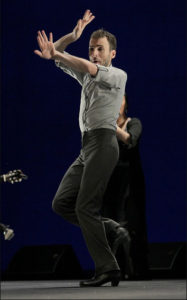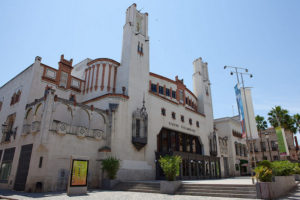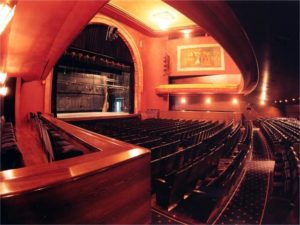 The Programme looks sparser this year, after the enormously successful and special twentieth anniversary edition last year and there are fewer accompanying exhibitions, but the town is still full of festival-goers.
The Programme looks sparser this year, after the enormously successful and special twentieth anniversary edition last year and there are fewer accompanying exhibitions, but the town is still full of festival-goers.
We began this year with Marco Flores at Sala Paul, a performance space in a converted bodega building. The beginning of his set was startlingly modern as he performed alone on stage to a sound scape of urban noise – car horns, conversation, shouts and footsteps and the ticking of a large clock. Superb athleticism and artistry was immediately apparent, Flores, though largely self-taught, has the style of a classically trained dancer.
After this evocative and unusual beginning he was joined by guitarist, Jesus Nunez and singer, Mercedes Cortes and the set became much more traditionally flamenco. Flores’ technique is impressive and he danced with remarkable energy. The show is called Transito and, the venue programme notes informed me, is about his search for identity in the modern world.
Venue leaflets were necessary because, for the first time in many years, there was no official Festival Programme. Year after year this glossy, informative and inexpensive publication tells Festival-goers about the individual performers, as well as concurrent events, like exhibitions and food and drink. Not this year. The actual programme of events was not finalised in time for the publication deadline, I was told. As we know, it wasn’t online until Christmas time. This was because of Town Hall plans to close the theatre, one of the major festival venues.
and inexpensive publication tells Festival-goers about the individual performers, as well as concurrent events, like exhibitions and food and drink. Not this year. The actual programme of events was not finalised in time for the publication deadline, I was told. As we know, it wasn’t online until Christmas time. This was because of Town Hall plans to close the theatre, one of the major festival venues.
Teatro Villamarta was opened in 1928 and its distinctive towers form part of the skyline of central Jerez ( and are visible from my roof terrace ). It  boasts a regular programme of shows, music, drama and opera as well as flamenco. I have seen everything from Puccini to Mary Poppins there and some wonderful flamenco performances ( see Reversible ). It seats up to 1200 in stalls and a deep circle painted a warm red, but without the gilding seen in so many London theatres. Like many provincial theatres in Britain, however, it doesn’t pay its way and relies on a subsidy from the local authority. In Jerez the local authority has no money.
boasts a regular programme of shows, music, drama and opera as well as flamenco. I have seen everything from Puccini to Mary Poppins there and some wonderful flamenco performances ( see Reversible ). It seats up to 1200 in stalls and a deep circle painted a warm red, but without the gilding seen in so many London theatres. Like many provincial theatres in Britain, however, it doesn’t pay its way and relies on a subsidy from the local authority. In Jerez the local authority has no money.
So closure was mooted as early as last Summer and was due to take place at Christmas. A reprieve was granted until the Festival was over. Who knows what will happen now?
The theatre is at the centre of the Festival, not just as a performance space  for the bigger shows, but as organiser, ticket seller, educator and sponsor of other venues. Without the Teatro Villamarta the Festival would not be the same and might not take place at all. Unthinkable.
for the bigger shows, but as organiser, ticket seller, educator and sponsor of other venues. Without the Teatro Villamarta the Festival would not be the same and might not take place at all. Unthinkable.
Though not everyone agrees. I overheard one Spanish gentleman bemoaning the intrusion of all the foreigners at the festival – Japanese, Chinese, German, French… Presumably it had once been purely a local or just a Spanish affair and it had become increasingly international in flavour. A desire to return to less internationalist days chimes with views currently being expressed across Europe, including in Britain.
Perhaps that is why Marco Flores, though promising something innovative in his first piece, then returns to the more traditional. There is fine artistry and emotion on display, but only a nod to modernity, with a short reprise of the first piece right at the end. Maybe he is accurately reflecting the tenor of the times?
We will see….
If you enjoyed reading this article you might also enjoy Lamento Reversible Jazz Guitar Sherry wine, dancing and song


 RSS – Posts
RSS – Posts